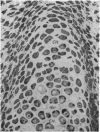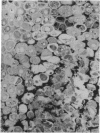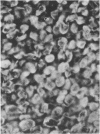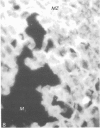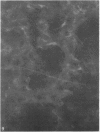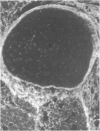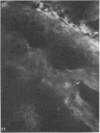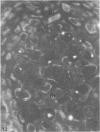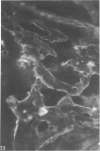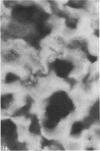Abstract
This study provides new information concerning the distribution of cartilage collagens in neonatal mammalian condylar cartilage. It became apparent that young cartilage cells contain pro-Type I collagen as well as pro-Type II collagen. The mature molecule of Type I collagen appears only in the extracellular matrix of the mineralisation zone close to the ossification front. Type II collagen, on the other hand, is apparent throughout the extracellular matrix as soon as the chondroprogenitor cells have differentiated into chondroblasts. In addition, Type II collagen is noticed in the core of the newly formed bone trabeculae within the primary spongiosa. Type IX collagen was found to be co-distributed with Type II collagen in cartilage and bone. Hypertrophic chondrocytes within the mineralisation zone, but in no other zone, demonstrate an intense reactivity for Type X collagen. Mild reactivity throughout the condylar process is encountered with regard to Type VI collagen. Perichondrium but not cartilage reacts positively for Type III collagen.
Full text
PDF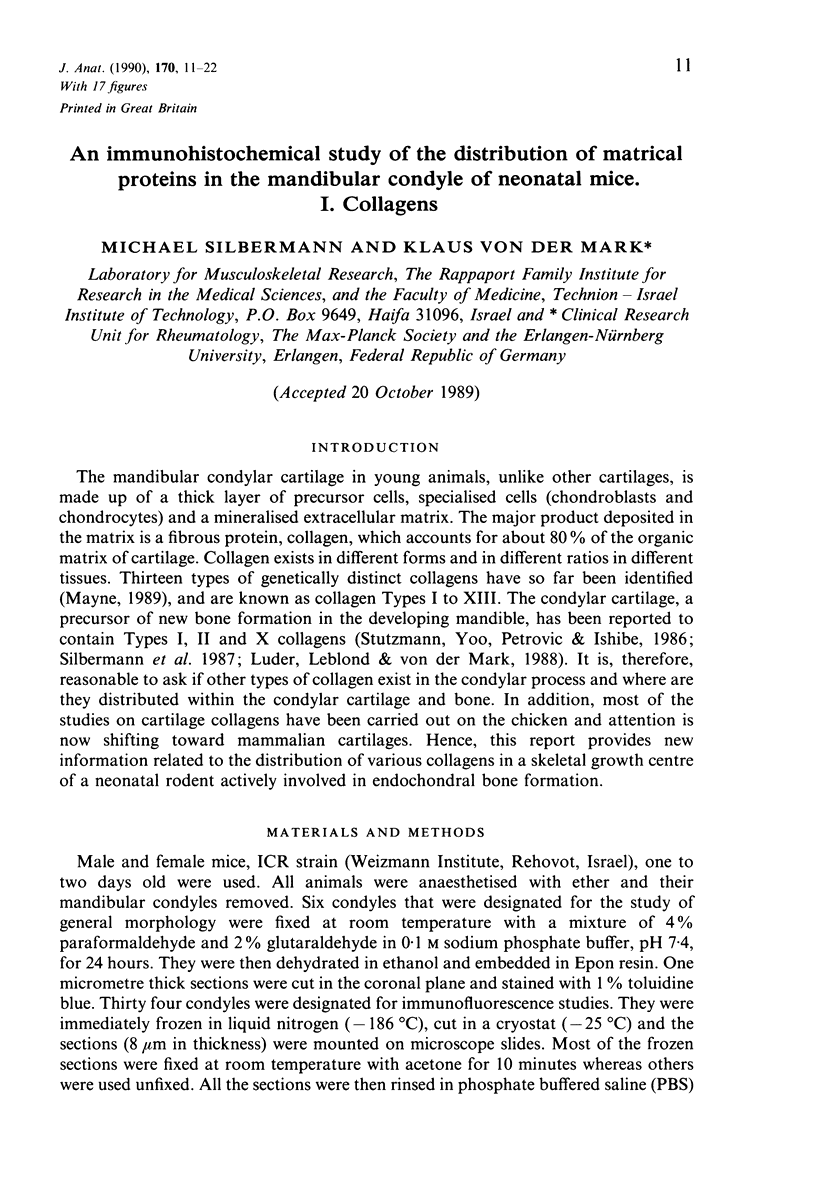
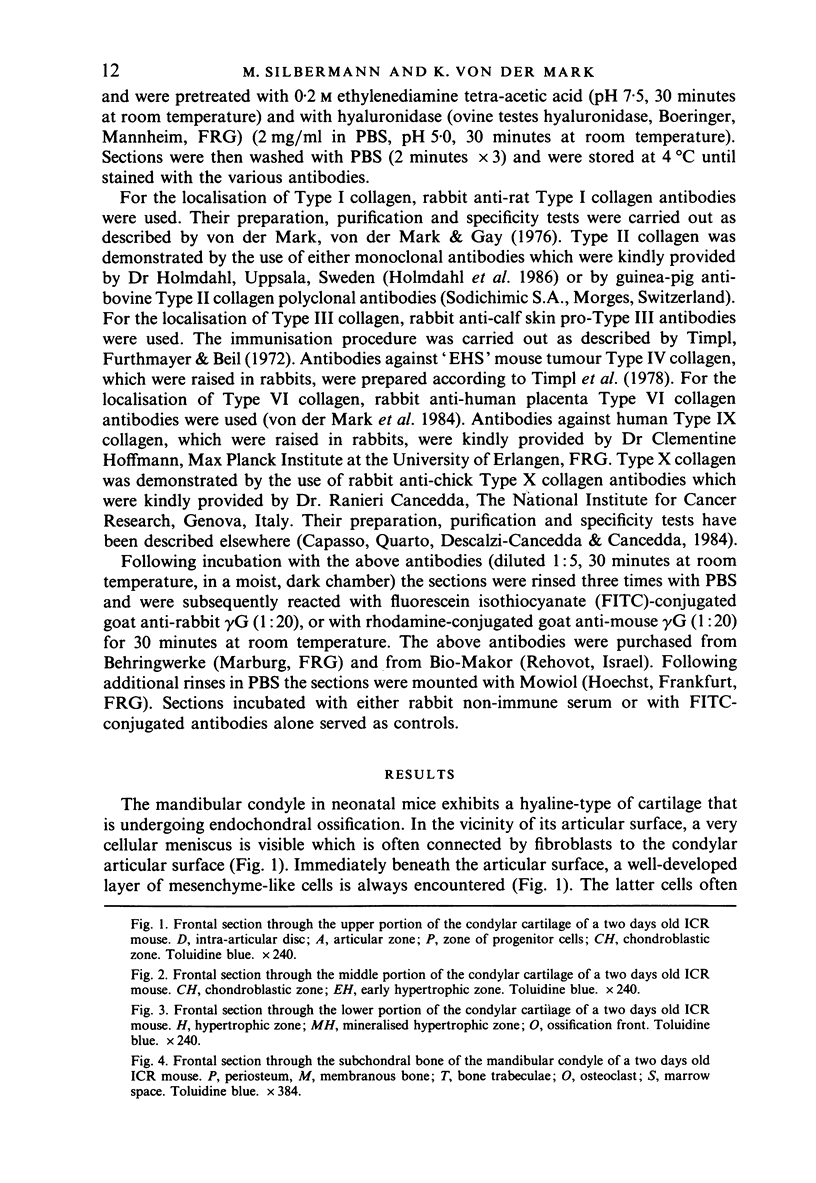
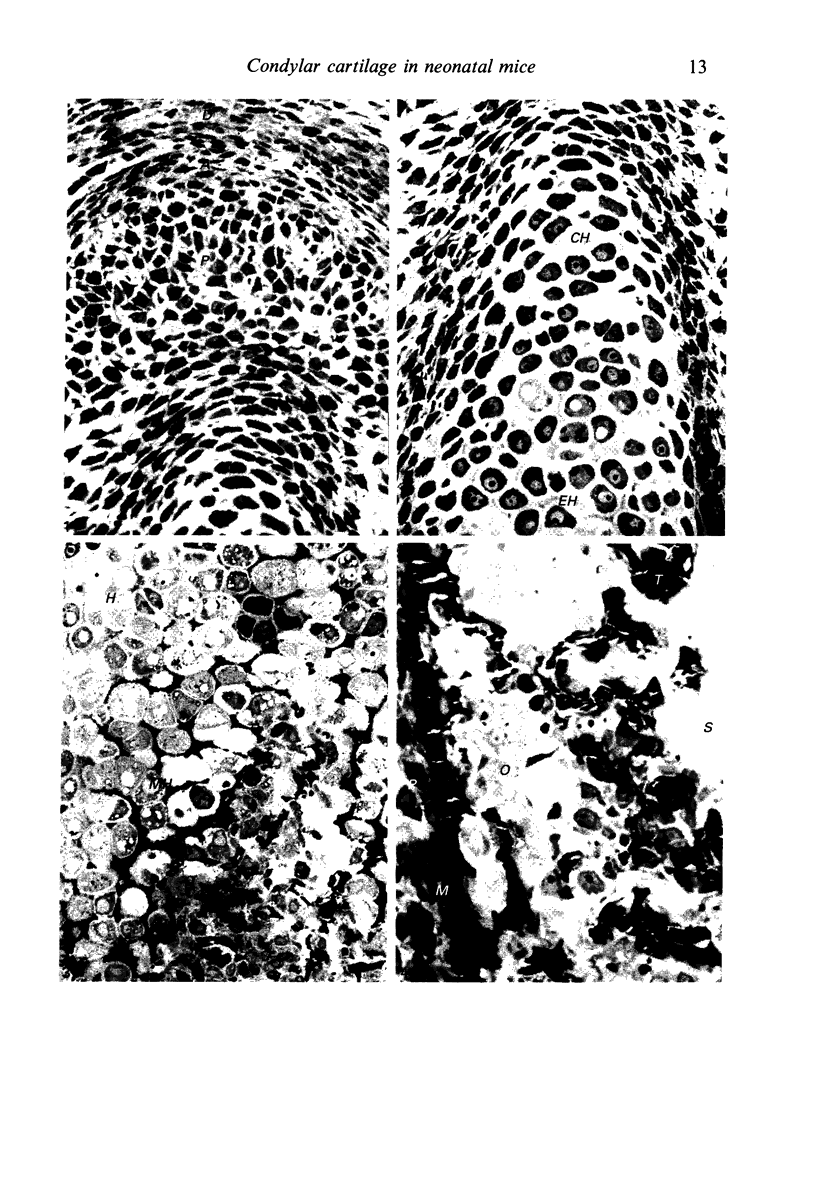

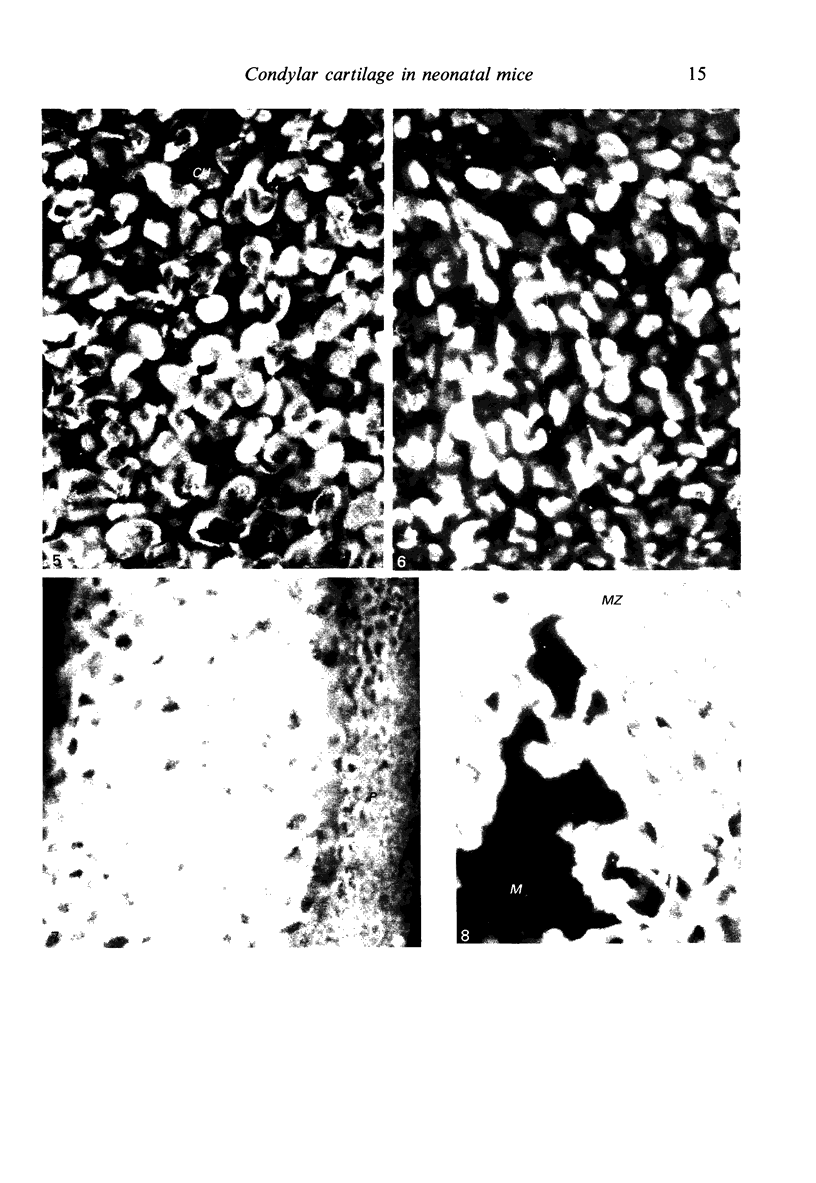
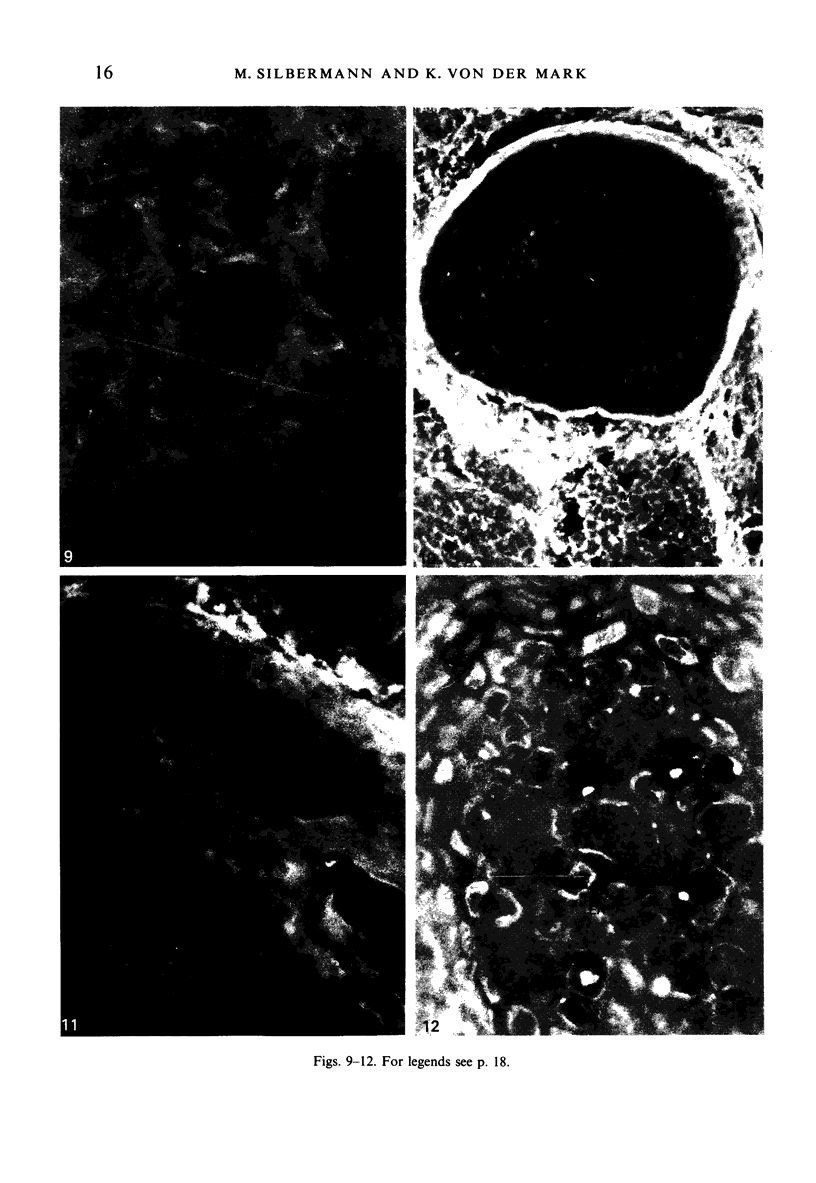
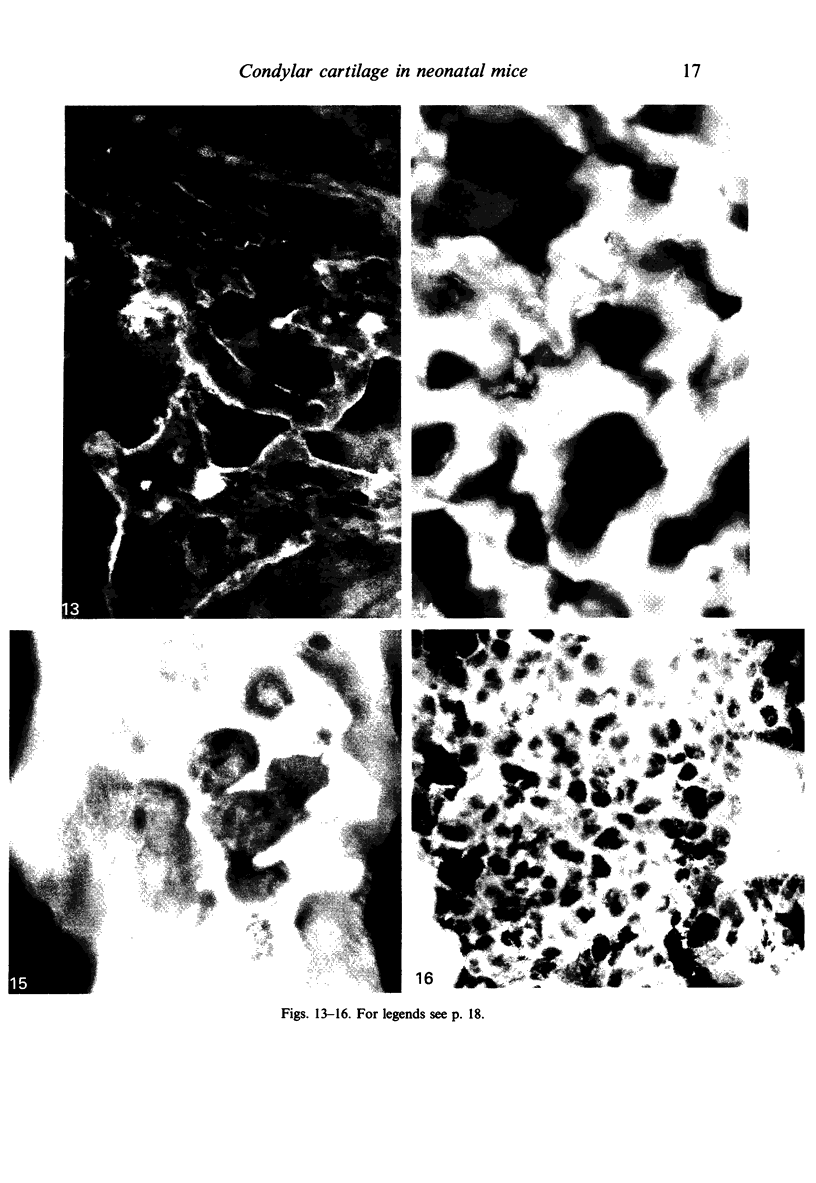
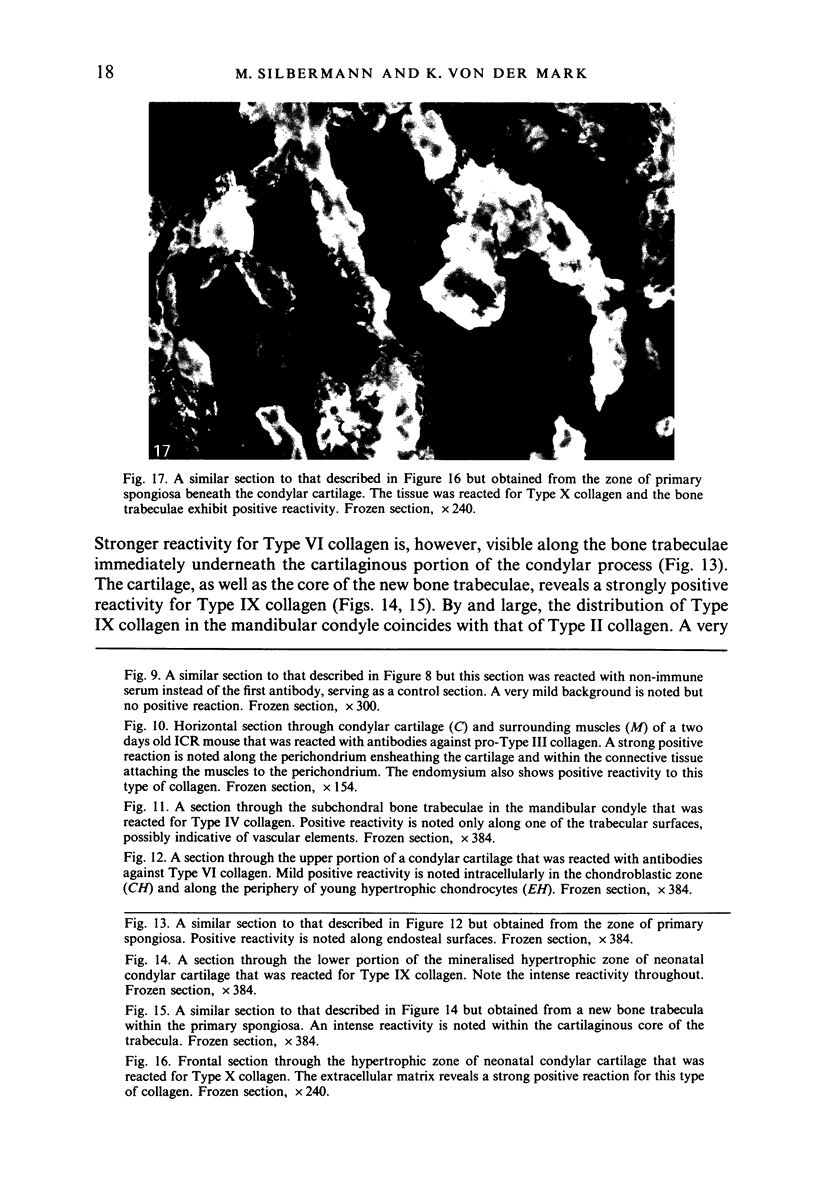
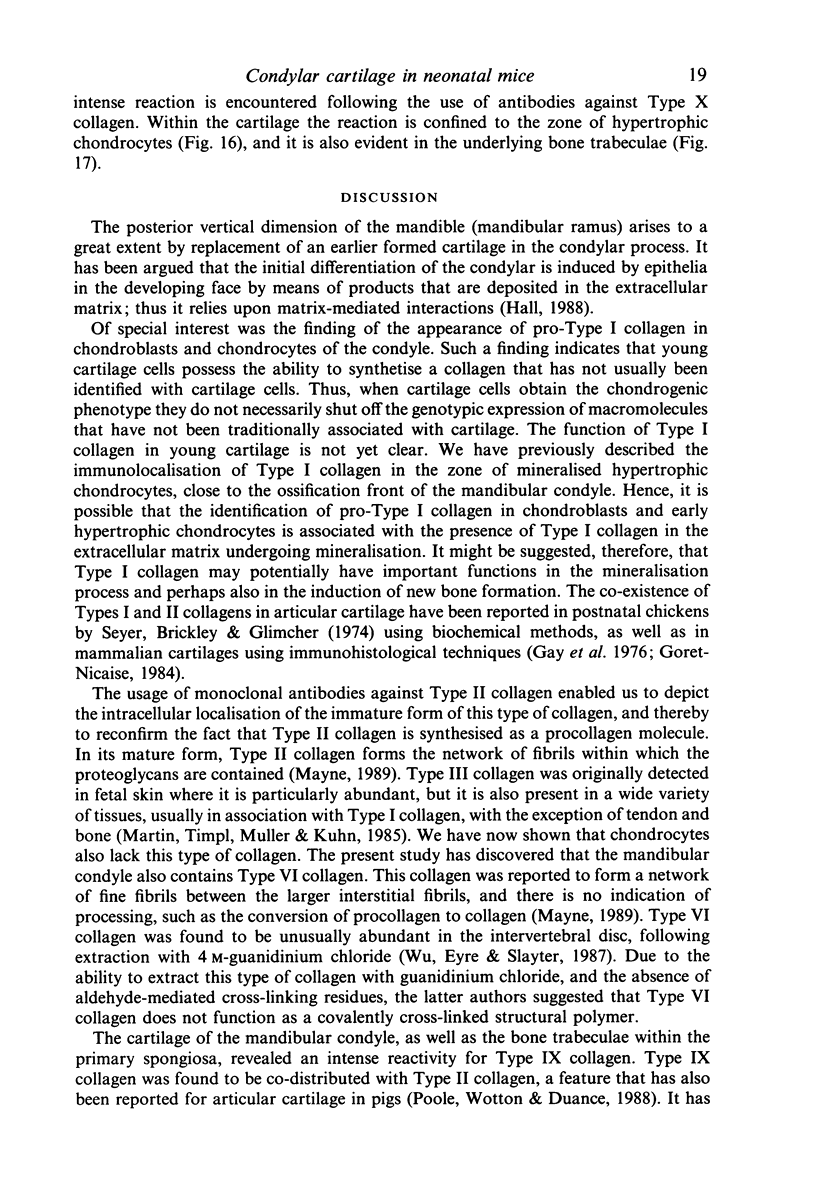
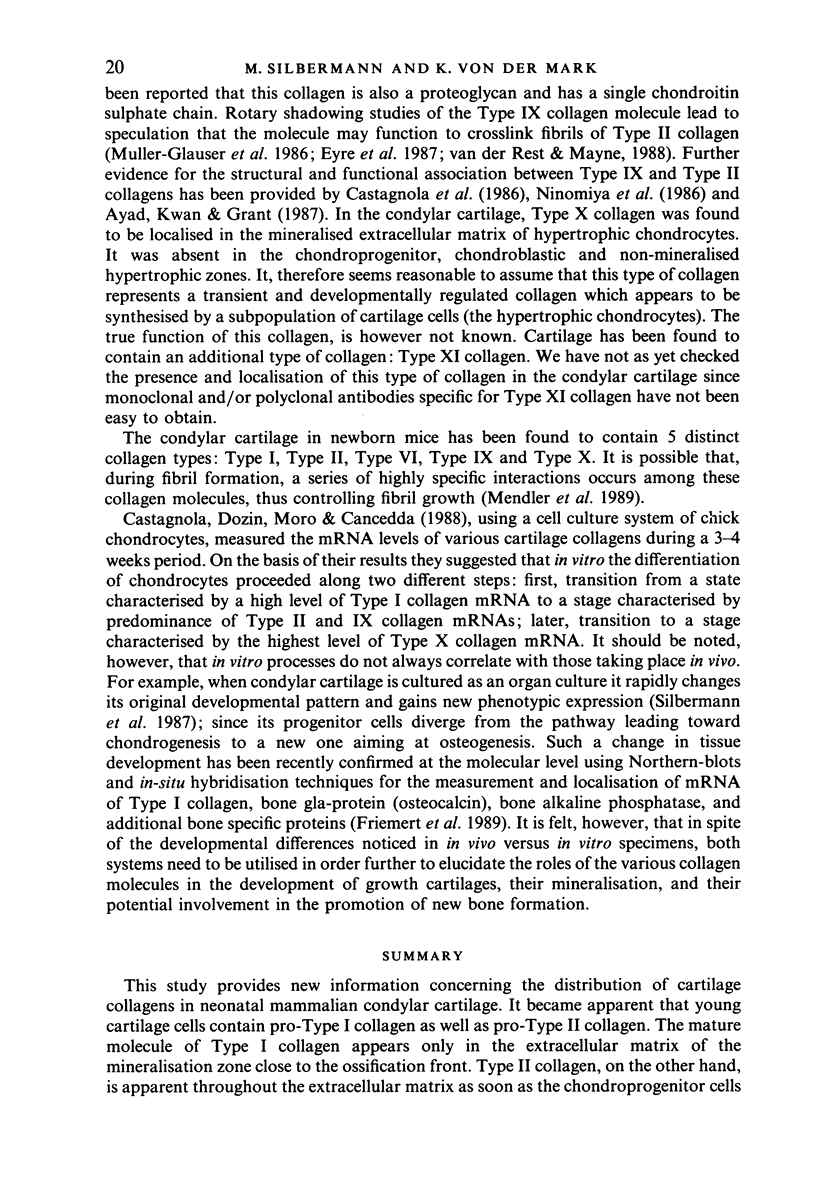
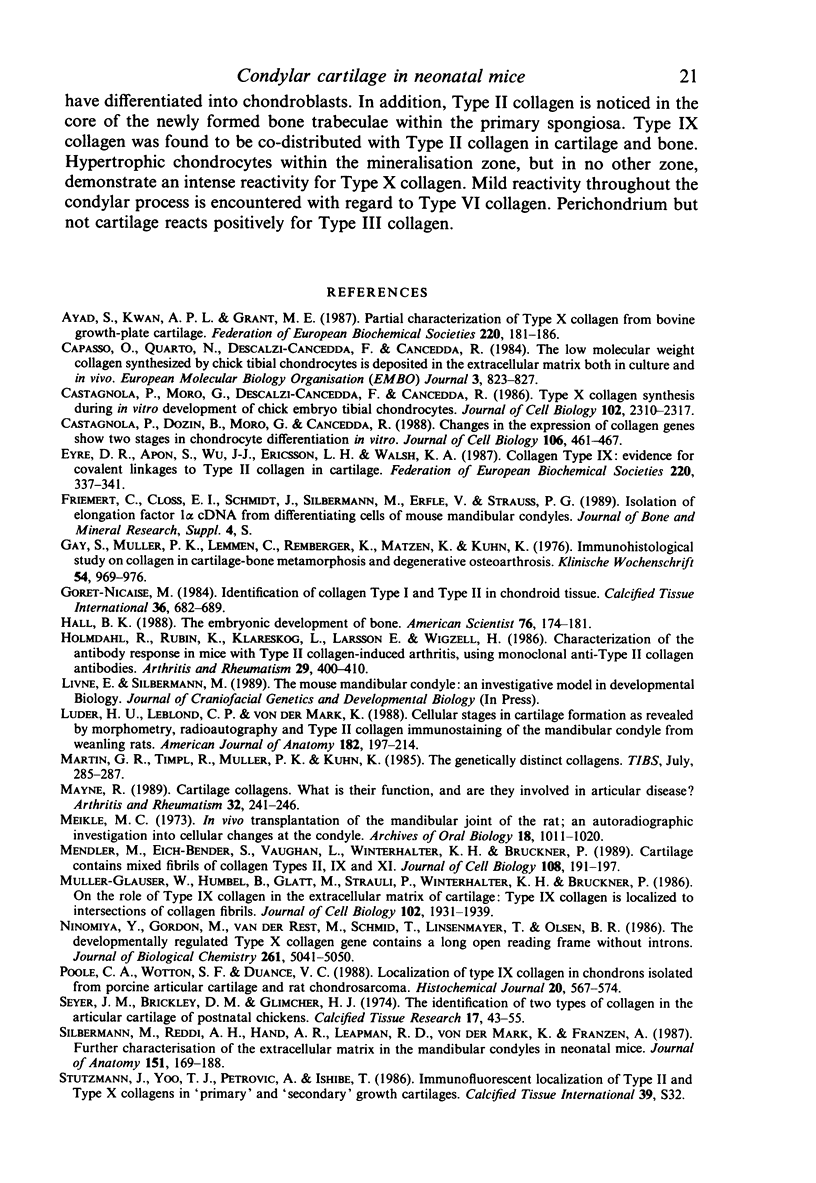
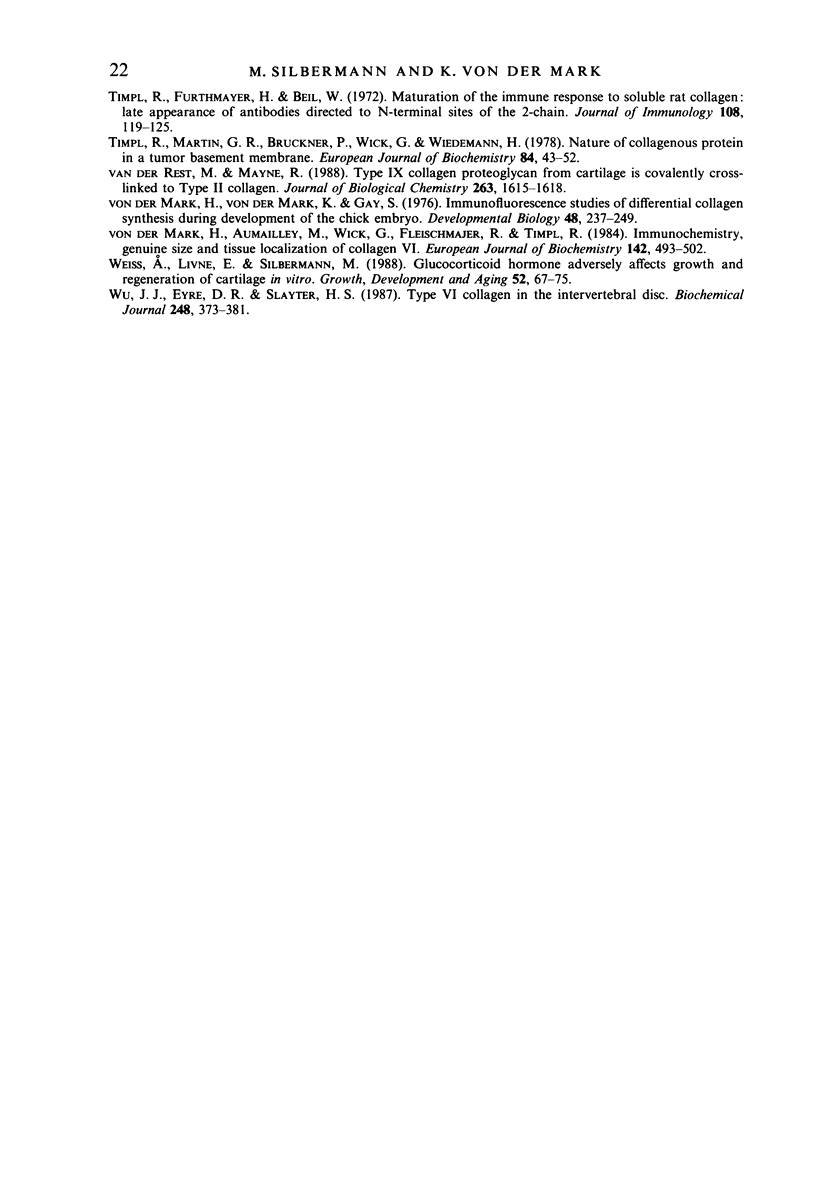
Images in this article
Selected References
These references are in PubMed. This may not be the complete list of references from this article.
- Ayad S., Kwan A. P., Grant M. E. Partial characterization of type X collagen from bovine growth-plate cartilage. Evidence that type X collagen is processed in vivo. FEBS Lett. 1987 Aug 10;220(1):181–186. doi: 10.1016/0014-5793(87)80899-2. [DOI] [PubMed] [Google Scholar]
- Capasso O., Quarto N., Descalzi-Cancedda F., Cancedda R. The low molecular weight collagen synthesized by chick tibial chondrocytes is deposited in the extracellular matrix both in culture and in vivo. EMBO J. 1984 Apr;3(4):823–827. doi: 10.1002/j.1460-2075.1984.tb01891.x. [DOI] [PMC free article] [PubMed] [Google Scholar]
- Castagnola P., Dozin B., Moro G., Cancedda R. Changes in the expression of collagen genes show two stages in chondrocyte differentiation in vitro. J Cell Biol. 1988 Feb;106(2):461–467. doi: 10.1083/jcb.106.2.461. [DOI] [PMC free article] [PubMed] [Google Scholar]
- Castagnola P., Moro G., Descalzi-Cancedda F., Cancedda R. Type X collagen synthesis during in vitro development of chick embryo tibial chondrocytes. J Cell Biol. 1986 Jun;102(6):2310–2317. doi: 10.1083/jcb.102.6.2310. [DOI] [PMC free article] [PubMed] [Google Scholar]
- Eyre D. R., Apon S., Wu J. J., Ericsson L. H., Walsh K. A. Collagen type IX: evidence for covalent linkages to type II collagen in cartilage. FEBS Lett. 1987 Aug 17;220(2):337–341. doi: 10.1016/0014-5793(87)80842-6. [DOI] [PubMed] [Google Scholar]
- Gay S., Müller P. K., Lemmen C., Remberger K., Matzen K., Kühn K. Immunohistological study on collagen in cartilage-bone metamorphosis and degenerative osteoarthrosis. Klin Wochenschr. 1976 Oct 15;54(20):969–976. doi: 10.1007/BF01468947. [DOI] [PubMed] [Google Scholar]
- Goret-Nicaise M. Identification of collagen type I and type II in chondroid tissue. Calcif Tissue Int. 1984 Dec;36(6):682–689. doi: 10.1007/BF02405390. [DOI] [PubMed] [Google Scholar]
- Holmdahl R., Rubin K., Klareskog L., Larsson E., Wigzell H. Characterization of the antibody response in mice with type II collagen-induced arthritis, using monoclonal anti-type II collagen antibodies. Arthritis Rheum. 1986 Mar;29(3):400–410. doi: 10.1002/art.1780290314. [DOI] [PubMed] [Google Scholar]
- Luder H. U., Leblond C. P., von der Mark K. Cellular stages in cartilage formation as revealed by morphometry, radioautography and type II collagen immunostaining of the mandibular condyle from weanling rats. Am J Anat. 1988 Jul;182(3):197–214. doi: 10.1002/aja.1001820302. [DOI] [PubMed] [Google Scholar]
- Mayne R. Cartilage collagens. What is their function, and are they involved in articular disease? Arthritis Rheum. 1989 Mar;32(3):241–246. doi: 10.1002/anr.1780320302. [DOI] [PubMed] [Google Scholar]
- Mendler M., Eich-Bender S. G., Vaughan L., Winterhalter K. H., Bruckner P. Cartilage contains mixed fibrils of collagen types II, IX, and XI. J Cell Biol. 1989 Jan;108(1):191–197. doi: 10.1083/jcb.108.1.191. [DOI] [PMC free article] [PubMed] [Google Scholar]
- Müller-Glauser W., Humbel B., Glatt M., Sträuli P., Winterhalter K. H., Bruckner P. On the role of type IX collagen in the extracellular matrix of cartilage: type IX collagen is localized to intersections of collagen fibrils. J Cell Biol. 1986 May;102(5):1931–1939. doi: 10.1083/jcb.102.5.1931. [DOI] [PMC free article] [PubMed] [Google Scholar]
- Ninomiya Y., Gordon M., van der Rest M., Schmid T., Linsenmayer T., Olsen B. R. The developmentally regulated type X collagen gene contains a long open reading frame without introns. J Biol Chem. 1986 Apr 15;261(11):5041–5050. [PubMed] [Google Scholar]
- Poole C. A., Wotton S. F., Duance V. C. Localization of type IX collagen in chondrons isolated from porcine articular cartilage and rat chondrosarcoma. Histochem J. 1988 Oct;20(10):567–574. doi: 10.1007/BF01002611. [DOI] [PubMed] [Google Scholar]
- Seyer J. M., Brickley D. M., Glimcher M. J. The identification of two types of collagen in the articular cartilage of postnatal chickens. Calcif Tissue Res. 1974;17(1):43–55. doi: 10.1007/BF02547213. [DOI] [PubMed] [Google Scholar]
- Silbermann M., Reddi A. H., Hand A. R., Leapman R. D., Von der Mark K., Franzen A. Further characterisation of the extracellular matrix in the mandibular condyle in neonatal mice. J Anat. 1987 Apr;151:169–188. [PMC free article] [PubMed] [Google Scholar]
- Timpl R., Furthmayr H., Beil W. Maturation of the immune response to soluble rat collagen: late appearance of antibodies directed to N-terminal sites of the 2-chain. J Immunol. 1972 Jan;108(1):119–125. [PubMed] [Google Scholar]
- Timpl R., Martin G. R., Bruckner P., Wick G., Wiedemann H. Nature of the collagenous protein in a tumor basement membrane. Eur J Biochem. 1978 Mar;84(1):43–52. doi: 10.1111/j.1432-1033.1978.tb12139.x. [DOI] [PubMed] [Google Scholar]
- Weiss A., Livne E., Silbermann M. Glucocorticoid hormone adversely affects the growth and regeneration of cartilage in vitro. Growth Dev Aging. 1988 Summer;52(2):67–75. [PubMed] [Google Scholar]
- Wu J. J., Eyre D. R., Slayter H. S. Type VI collagen of the intervertebral disc. Biochemical and electron-microscopic characterization of the native protein. Biochem J. 1987 Dec 1;248(2):373–381. doi: 10.1042/bj2480373. [DOI] [PMC free article] [PubMed] [Google Scholar]
- van der Rest M., Mayne R. Type IX collagen proteoglycan from cartilage is covalently cross-linked to type II collagen. J Biol Chem. 1988 Feb 5;263(4):1615–1618. [PubMed] [Google Scholar]
- von der Mark H., Aumailley M., Wick G., Fleischmajer R., Timpl R. Immunochemistry, genuine size and tissue localization of collagen VI. Eur J Biochem. 1984 Aug 1;142(3):493–502. doi: 10.1111/j.1432-1033.1984.tb08313.x. [DOI] [PubMed] [Google Scholar]
- von der Mark H., von der Mark K., Gay S. Study of differential collagen synthesis during development of the chick embryo by immunofluorescence. I. Preparation of collagen type I and type II specific antibodies and their application to early stages of the chick embryo. Dev Biol. 1976 Feb;48(2):237–249. doi: 10.1016/0012-1606(76)90088-9. [DOI] [PubMed] [Google Scholar]




